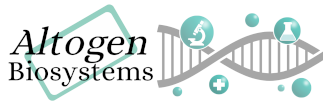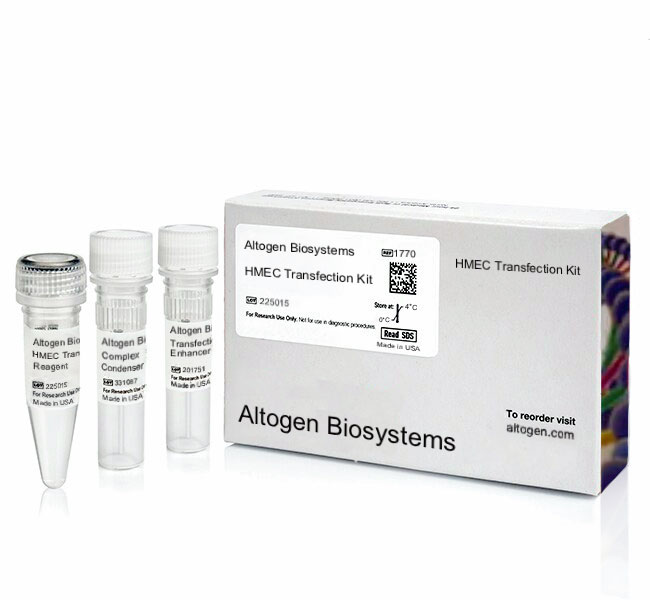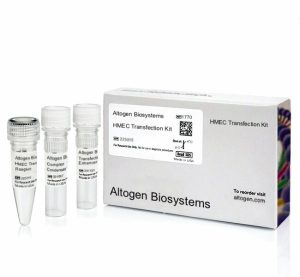Description
Purchase Orders: Click “Add to Cart” button to order, then email PO to orders@altogen.com.
Product Availability: In Stock.
Transfection Reagent for HMEC Cells (Mammary Epithelial, Breast Cancer Cells)
- Proprietary cationic lipids formulation
-
High transfection efficiency of small RNA (siRNA, shRNA, miRNA), mRNA, pDNA
-
Kit includes Transfection Enhancer an Complex Condenser reagents
-
Work in the presence of serum
-
A proven reagent for establishing stable cell lines
-
Optimized transfection protocols are adapted for use with both standard & reverse transfection methods
-
Download HMEC transfection protocol: [PDF]
- Download HMEC CRISPR/Cas9 transfection protocol: [PDF]
- Download PowerPoint presentation for HMEC cells transfection kit: [PPT]
- UPC/GTIN/EAN: 860002089774
-
Brand: ALTOGEN®, developed and manufactured by Altogen Biosystems
Transfection Efficiency:
Reagent exhibits at least 76% transfection efficiency of siRNA delivery. Transfection efficiency was determined by qRT-PCR.
Product Description:
This transfection kit is specially designed for the HMEC cells, a human breast cancer cell line. Transfection reagent supplemented by complex condenser and transfection enhancer ensures high efficiency in delivering cargo biomolecules into HMEC cells.
Transfection Protocol and SDS:
Download Altogen Biosystems HMEC Transfection Protocol: [PDF]
Download SDS: [PDF]
HMEC Cell Line:
Breast cancer represents the most prevalent malignancy among women, with more than 300,000 new cases detected every year. Also, it results in over 40,000 deaths in the United States annually, making it a serious public health challenge, according to the American Cancer Society. Breast cancer preclinical research is essential for the investigation of tumor development as well as the therapeutic potential of a new drug candidate. The HMEC breast cancer cell line is widely considered to be an effective tool for carrying out carcinogen screening. The HMEC (human mammary epithelial cancer) cell line was derived from glandular tissue of a female breast cancer patient and is a suitable host for studies related to breast cancer biomedical research. HMEC cell line displays cuboidal morphology with a characteristic pattern of swirls. Research applications of the HMEC cell line include carcinogen screening and three dimensional culturing. Altogen Biosystems provides optimized cationic lipid-based transfection reagent kits for the HMEC breast cancer cell line.
HMEC (Human Mammary Epithelial Cell) is a cell line derived from normal human mammary epithelial cells. These cells are commonly used as a model system to study breast cancer development and progression, as well as to investigate normal mammary gland biology. HMEC cells are frequently used in research to study the molecular mechanisms underlying breast cancer development and progression, including the role of genetic and epigenetic changes, the effects of environmental and lifestyle factors, and the interaction between cancer cells and the surrounding tissue. They are also used to evaluate the effectiveness of new anti-cancer drugs and to identify potential therapeutic targets and biomarkers of breast cancer. One of the advantages of using HMEC cells is that they are derived from normal breast tissue, which allows researchers to study the early stages of breast cancer development and to identify potential targets for early intervention and prevention. HMEC cells can also be transformed to create in vitro models of breast cancer, which can be used to study the progression of the disease and to evaluate the effectiveness of new therapies.
Data:
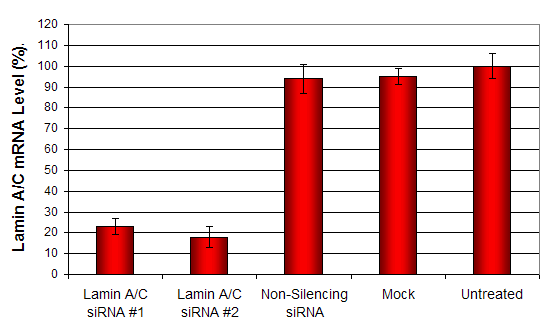
Figure 1. siRNAs targeting Lamin A/C mRNA or non-silencing control siRNA were transfected into HMEC cells following the recommended protocol. At 48 hours post-transfection the cells were analyzed by qRT-PCR for gene expression levels. 18S rRNA levels were used to normalize the Lamin A/C data. Values are normalized to untreated sample. Data are means ± SD (n=3).
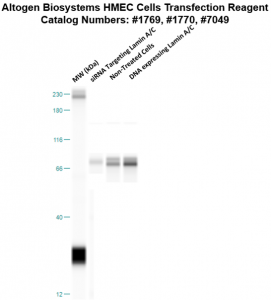
Figure 2. Protein expression of Lamin A/C in HMEC cells. DNA plasmid expressing Lamin A/C or siRNA targeting Lamin A/C were transfected into HMEC cells following Altogen Biosystems transfection protocol. At 72 hours post-transfection the cells were analyzed by Western Blot for protein expression levels (normalized by total protein, 10 µg of total protein loaded per each well). Untreated cells used as a negative control.
Selected in vivo transfection product citations (ALTOGEN® IN VIVO Transfection Kits used in the following publications):
- Nature. 2008 454(7203):523-7. Innate immunity induced by composition-dependent RIG-I …Saito et al [PDF]
- Am J Pathology. 2010 177(4):1870-80. Role of ocular complement factor H in a murine model … Lyzogubov et al [PDF]
- Nature Biotechnology. 2011 29(4):341-5. Delivery of siRNA to the mouse brain by … Alvarez-Erviti et al [PDF]
- Cancer Research. 2011 71(15):5144-53. Inhibition of miR-193a expression by… Iliopoulos et al [PDF]
- RNA. 2010 16(11):2108-19. RNase L releases a small RNA from HCV RNA that refolds … Malathi et al [PDF]
- Diabetologia. 2012 55(7):2069-79. The p47phox- and NADPH oxidase organiser 1 … Youn et al [PDF]
- British Journal of Cancer. 2012 107(3):516-26. TIGAR induces p53-mediated cell-cycle … Madan et al [PDF]
- Hypertension. 2014 63(2):353-61. Tissue transglutaminase contributes to … Liu et al [PDF]
- Circulation Research. 2010 15;107(8). Kruppel-like factor-4 transcriptionally regulates … Cowan et al [PDF]
- Hypertension. 2012 59(1):158-66. Role of uncoupled endothelial nitric oxide synthase … Gao et al [PDF]
- Jounal of Biological Chemistry. 2012 287(4):2907. Chaperoning of mutant p53 protein … Gogna et al [PDF]
- PLoS Pathogens. 2012 8(8) Uridine composition of the poly-U/UC tract of HCV RNA … Schnell et al [PDF]
- J Proteome Res. 2012(11) Retinal proteome analysis in a mouse model of oxygen-induced … Kim et al [PDF]
- J Transl Med. 2010 15;8:133. Prevention of hyperglycemia-induced myocardial apoptosis … Zhang et al [PDF]
- Mol Cell Biol. 2013 33(7). SCO2 induces p53-mediated apoptosis by Thr845 phosphorylation … Madan et al [PDF]
- Hypertension. 2015 65(2):430-9. Neurokinin 3 receptor and phosphocholine transferase… Parchim et al [PDF]
- Gastroenterology. 2011 141(2) Differential type I interferon-mediated autophagic trafficking … Desai et al [PDF]
- PLoS Pathog. 2014 10(10) Exosomes from hepatitis C infected patients transmit HCV … Bukong et al [PDF]
Altogen Biosystems is a life sciences company that offers cell type-specific and pre-optimized transfection products, elecroporation kits, and in vivo delivery reagents. Advanced formulation of reagents and optimized transfection protocols provide efficient intracellular delivery of protein, DNA, mRNA, shRNA and siRNA molecules. Read more about transfection technology at Altogen’s Transfection Resource. Altogen Labs provides safety and efficacy preclinical research services. GLP-compliant studies for IND applications, and drug development, including over 90 in-house validated xenograft models, safety toxicology, etc (visit AltogenLabs.com).
Volume Options:
- 0.5 ml (Catalog #1769)
- 1.5 ml (Catalog #1770)
- 1.5 ml CRISPR (Catalog #2155)
- 8.0 ml (Catalog #7049)
Purchase Orders: Click “Add to Cart” button to order, then email PO to orders@altogen.com.
Product Availability: In Stock.
